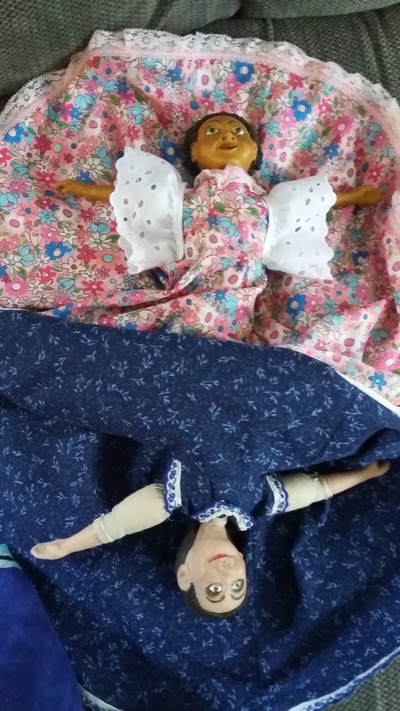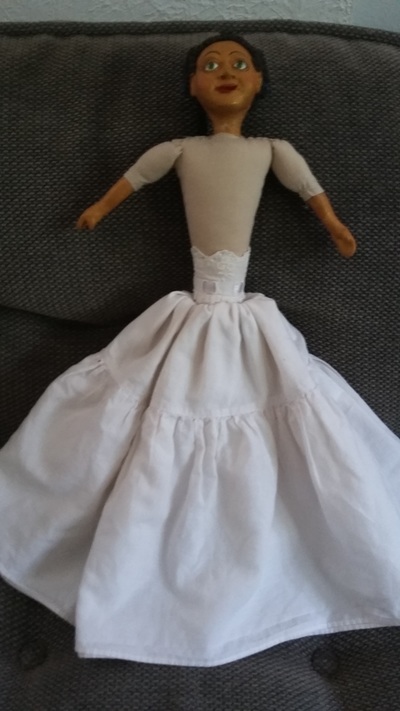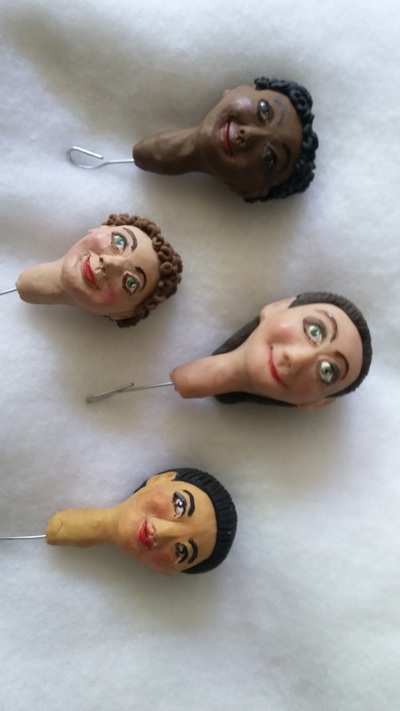This is the second post in a series of articles about my current project: REVISIONING FLIP DOLLS. I received a Conant Grant from the Potomac Fiber Arts Guild and as part of this project, I am 11/ 27/16 NOTE: A couple of corrections from Ellen: "my granddaughter is NOT adopted! she is my daughter's natural child. It's my sister's kids who are from Korea. Thank you to Carol Brobst, who introduced me on-line to Ellen Tepper http://www.ellentepper.com/about.htm. Carol is a member of PFAG and is herself a fiber artist (www.ambrosianfiberarts.com) and also a harpist, like Ellen Tepper. And thank you to the Potomac Fiber Arts Guild, whose Conant Grant helped make it possible for me to do this project.
Background and introduction: Tepper is primarily a harpist and early music performer. I met her through PFAG member, Carol Brobst. The interview was conducted over the phone in two sessions. She talked about her loves of music and art and finding a balance between the two demanding pursuits, especially for one who is a perfectionist as she is. Tepper plays multiple instruments and creates art in a wide range of media, including embroidery, doll making, quilting and painting on glass. Ellen told me she is about to publish a book of rounds for harpists, part of a series called The Harpers Accomplice Plays the Round. She wrote the book and the music and also illustrated it with “part art and part cartoon.” Tepper thinks of herself primarily as a musician. She told me that she started making dolls as a sort of relief from the challenges of practicing and performing music. Her first dolls were music related. In 1997 she made a 1799 historic harpist doll including the harp. She was interested in that specific historical period in making her dolls. She used sculpey clay. She also got interested in making what she called “lounge lizards” playing early instruments. Her earlier influences were a childhood in Austria, where she was more interested in making doll clothes than playing with her dolls. She got her embroidery skills from her dad, and sewing skills from her mom. When Tepper was small, her dad had to stay in bed with a prolapsed lung-and teaching himself to knit, knitted a green sweater. Having learned embroidery from his mother, he taught his daughter the lazy daisy and French knot stitches. Tepper’s mother is a German refugee and her father’s parents are from Slovakia. The family lived in Austria for the early years of her life. She learned to play the harp when she was eight years old, also in Austria. Before Tepper started to make dolls, she used to make embroidery, entering in embroidery competitions. One of Tepper’s first dolls was a portrait of a historic harp restorer whom she worked with. She used steel wool to depict his grey hair, plastic for his eyes and dressed the doll all in leather. She made the doll a historic pedal harp with tools and a bag and put it all in a presentation box lined with satin. She says he has this doll at home now and “thinks it’s a bit creepy.” Start with flip dolls Tepper became especially interested in the medium of flip dolls as a way of supporting her daughter who as a white woman, had just adopted a black girl. This first black/white flip doll for her granddaughter was meant to be played with, so it was important that the doll be strong and sturdy. She also wanted to make sure that the clothes could be removed and put back on easily. She learned to make doll faces from a book by Maureen Carlson who teaches a method of making doll heads out of clay in a sort of caricature style. After exploring working with various self or oven hardening clays, she at first determined that Fimo clay was the strongest and worked best, especially when the dolls were meant to be played with. More recently she found a kind of clay called Living Doll, a super sculpey, that comes in Caucasian flesh color. She pre-baking the eyeballs all at once, marks the eyes, then constructs the face around that. She then adds the more solid smaller features to the dolls To make the flip dolls, Tepper first stitches two permanently attached underskirts and then creates two separate outside dresses, one for each side of the doll. The skirt is made from a fabric circle with the opening to the skirt in the center. Then the pattern is built up with a series of triangles. The body is made on a wire armature with tin foil. She bakes the parts of the doll in successive bakes, first the armature, then the face, which she paints with real make up before she bakes it, then finally hair. She likes to use old clothes such as cast off shirts, especially collars and side seams or pre-gathered hems so that the skirts don’t need to be stitched from scratch. She gets supplies such as buttons, snaps, borders and cuffs from second hand stores. Purpose of flip dolls for Tepper: Tepper uses the flip dolls to represent mothers and daughters who are of different races as a way to show how they are connected to each other. She is interested in the possibilities of representing ethnicities in her flip dolls, particularly between mothers with daughters of mixed ethnicity. Her next flip doll is for a niece adopted from Korea. She has a fascination with recombinant families. Fine art vs Craft: She says it all depends on the medium. She sees embroidery as fine art and dolls as craft. She sees painting as art. She likes elevating one into the other, like taking early music or Irish folk music and playing it as if it’s classical. Symbols in doll making: She once made dolls as totems, for instance creating a “Princess Bra Bra doll”, when her sister had breast cancer. She made bodies out of old bras, tiaras made of hooks and eyes and various bits of the bra as clothing. At another time she created lots of cookware, frying pans and spatulas for a “Giant lizard cook” as a gift for a cook friend. She made early music instruments for the Lounge lizard, later giving them more modern instruments. She’s inspired the positions that the bodies of musicians get into when they play. Some more questions: Does your personal experience come into doll making? “Probably but hard to say. When I’m making art I’m thinking of music. When I’m making music I’m always thinking of art. It’s a tug or war but also they’re also mutually supportive. When I get up in the morning, not what am I going to do but what medium I’m going to use.” Where are you headed now with doll making? “I want to make that have four or five heads. I’m also waiting to meet with my niece to get the Asian face right. Making dolls makes me look more carefully at people’s faces. It’s seasonal for me. I tend to make visual things in the summer and do more music in the summer.” Do you collaborate with other artists? “I collaborate musically. But artistically I tend to be solitary. I used to do things with my sibling, my brother. We used to make things together. I once went with my brother to a friend’s house and overnight we made a room sized foot out of papier mache. I would enjoy working with the community to make a quilt. But mostly I like absolute control of a project.” What advice do you have for working with homeless women making flip dolls? “I would like to do that project too. They could do flip doll of what they wish they were or where they want to get to, as opposed to where they were, the worst part. A caricature of the really bad and the really good could be inspiring. I’d also suggest the idea of using recycled materials. Old windows, old bras. buttons and button holes.” What’s your dream project? “I made my own unicorn tapestry as a teen-ager… I used to dream of a gallery show where all the art is mine but I could also play my harp at it. Another gallery might be interested in my paintings on glass where I work in an opposite way. ‘Windows’ is the name of the project. I paint from the back and think backwards, doing finishing touches first. Or a dream job would be three clones of myself and we could play trios. I’ve made a lot of pictures where I’m the model, for instance a cartoon of sequential harpists pulling harps behind them on a skate board, with the harps and skate boards sequentially getting smaller.” Have you ever had a creative block and what did you do then? “I go dancing. I’ve had a lot of blocks. I had one recently. It’s like a post partum thing that happens. A piece of art is done and you don’t know what to do with yourself. Once I was blocked physically, with tendonitis. All my regular avenues to make myself feel better were closed. I read a lot, drank a lot and got a really good tan. It’s scary to be blocked. Making art is Important for my emotional well being. I used to call myself ‘compulsively creative.’ And art is also a source of money. But I believe if there are too many irons-you need a bigger fire. If there’s too much on your plate, get a bigger plate. “ About perfection: “The need for perfection in art comes from being in embroidery competitions where if something is frayed, it’s judged as imperfect. In music it’s perfection first, then emotion.” Tepper is very self disciplined, if there’s a music deadline, she cleans out her house of art projects and won’t do art. “For music you have to practice over and over again to achieve perfection. Being an artist balances the invisibility of being a musician. You only do that art once, but music is over and over.” She says “try to teach art or music to someone else to learn better.” Again, if you would like to learn more about Tepper and her music, here is here website. http://www.ellentepper.com/about.htm. Some of her art can be found on her Facebook page. This is one of the first times she has shown her flip dolls publicly. I am honored to have had this chance to get to know her and her dolls better.
0 Comments
Leave a Reply. |
ErikaI've been making dolls for about ten years now. I believe that dolls serve as representations and reminders of the best part of ourselves. I am excited to share with you here my learnings about new methods and techniques for doll making and healing. So glad you are here! Categories |
Proudly powered by Weebly








 RSS Feed
RSS Feed